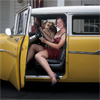Electronic Collars vs Traditional Leashes for Exercising Dogs on Town Streets—a Cause of Debate in One Small Town in Missouri
By Sophia Yin, DVM, MS
A reader, Donnie Rion of Carl Junction Missouri, recently emailed with the following dilemma, which will be debated in a town council meeting later this week.
The town I live in is looking to revise their leash law to allow dog owners to us electronic leashes to walk their dogs. Are they good enough to physically control dogs in all situations? One reason council is looking into this is that there are people here that have golf carts and they are complaining that is to hard for them to drive their golf carts and hold onto their dog leashes at the same time, so they want to be able to use electronic ones so they don't have to hold onto a leashes while the drive a golf cart.
What People Think Happens When You Use an Electronic Collar
When people think of electronic leashes, known more precisely as electronic shock collars, they imagine their dog trotting next to them in an unerring path as if held in place by an invisible force field. With this “miracle cure” for pulling or even running away, they envision everything they can do on their walk now that they can safely ignore their dog—listen to the radio, text-message their friends, or just power ahead in a daydream state. And even if a squirrel, cat or another dog crosses their path, they imagine that the invisible forcefield will magically hold the dog by their side.
What Really Happens When You Use an Electronic Collar or Electronic Leash
While, in the hands of an expert, many dogs can learn to consistently trot by one’s side even in the face of major distractions, for most owners this is not likely to occur. There are several reasons for this:
First, the dog has to be taught to stay next to you and to do so at all times. For the collar to work, the owner must be able to give the shock right when the dog starts getting ahead, falling behind or walking or moving too far to the side, even after the dog knows the heel behavior. For instance if the dog sees a buddy and starts to run off to greet him, the owners must deliver the shock immediately as he starts, not 1-2 seconds later. That means, the owner must always be holding the electronic collar with finger on the delivery button or the dog will know that sometimes he has at least a 2-4 second window to do something a human might consider naughty. And, if the owner cannot deliver the shock at the very start of the dog running off, the dog is not learning that running off is the problem. In the dog’s mind he is being punished for whatever he is doing at that exact moment he receives the shock.
Even if the owner is able to always be ready and holding the remote control at all times, there are other factors too. The collar has to be charged similarly to how you’d charge a video camera, and it must be snuggly fit. A loose fit or weak charge results in an unreliable shock. The dog must always wear a real electronic collar rather than wearing a fake or dummy collar. Dummy collars are often used in place of an actual electronic collar when the owners have to use the real collar on another dog but don’t want to pay for two electronic collars. Another thing most people don’t consider is that all electronic collars are not created equally. Some are poorly built and don’t consistently work.
One huge issue, regardless of how careful one is in addressing all of the concerns listed above, is when using the collar, the shock level must be at the right intensity for the dog’s level of distraction or the dog’s level of excitement. In one situation a low level shock, just enough to remind him of what happens if he doesn’t respond but not enough to startle, scare or hurt him is most appropriate. A low level may be all that’s needed to get the dog to move back by your side. But in another situation, like a squirrel running by, anything short of the “super high” setting and Rover won’t even feel it. In fact, even with the collar set to deliver the highest level of shock, some dogs will ignore the pain when they are extremely motivated to perform the undesired behavior.
You can’t really solve the problem by keeping the collar on “super high” at all times. If Rover just drifts one step out of place it’s not really fair to give a shock that will make him leap out of his skin. Many owners would hesitate to be so unfair and they would elect to avoid correcting this little error at all if they only have the option of using a super high level shock. As a result the dog’s grey zone for where he’s allowed to be would get wider and wider. Of course if you have the collar on a level appropriate for correcting small errors and Rover suddenly bee-lines after a deer, your first zap is too low and you then have to adjust the level—most often with your free hand. That adds 2-4 seconds as you try to reach the appropriately high level.
Even More Can Go Wrong in the Hands of the Average Dog Owner
Now let’s add into this mix the fact that most dog owners are not dog training experts. So whereas an expert may expect the dog to trot along in a perfect heel position and every time the dog surges slightly ahead or falls behind or starts straying to the side, the dog gets a zap, the regular dog owner has shades of grey not to mention long periods of mental snoozing on the job. The typical dog owner’s criteria for using the collar changes randomly. Their dog runs ahead of them or weaves back and forth or is in the general area and it’s okay at least nine out of ten times. Then once in a while that same behavior earns a zap. Its not unusual that the owner never quite trains their dog what heel position is in the first place. Because realistically if they did, they could just wear a hands free leash (such as the buddy system) which ties around their waist so even when using an electronic collar the leash would not be an inconvenience at all.
In my experience, about 95% of individuals using an electronic collar use it incorrectly or are in a family where at least one of the family members who handles the dog uses it incorrectly meaning the dog gets mixed signals about what is or is not appropriate behavior. I’ve also seen many people use it to punish their dog for something it did 3 to 5 minutes earlier. They are angry so hit the button while the dog is not engaged in an inappropriate behavior. The dog cannot be expected to learn what is allowed and what is not under these conditions, which sadly are not uncommon.
Now Add the Golf Cart Issue
On top of all of the electronic collar issues there’s one more factor—the golf cart. If it’s on a bike path without cars and with very low traffic and the driver is very focused on both driving and on the dog, it may be ok. But dogs plus moving vehicles in the street are generally not a good mix. When on leash you’d have to be careful that the leash doesn’t dangle too closely to a wheel or that you don’t accidentally pull the dog close enough to be run over. Off leash on a regular two-way street with regular cars, eventually a town dog will get run over while the owner multitasks by holding the electronic collar, keeping an eye on the dog, and also trying to watch the road. Add the ubiquitous cell phone to the mix and it’s a real recipe for disaster. It’s also possible that the dog could help create an accident with another vehicle. So the entire issue of having dogs on electronic collars so they can be exercised next to golf carts on regular residential streets without a leash is a safety issue for dogs as well as everyone else on the road. If it’s on a bike path with low traffic, the safety vs risks are up to your city council to decide.
E-collar vs. traditional leash debate
6 posts
• Page 1 of 1
http://positively.com/2011/01/17/electr ... wn-streets—a-cause-of-debate-in-one-small-town-in-missouri/
"I don't have any idea if my dogs respect me or not, but they're greedy and I have their stuff." -- Patty Ruzzo
"Dogs don't want to control people. They want to control their own lives." --John Bradshaw
"Dogs don't want to control people. They want to control their own lives." --John Bradshaw
-

TheRedQueen - I thought I lost my Wiener... but then I found him.
- Posts: 7184
- Location: Maryland
Not a good idea at all
Not only am I a member of the Michelle says my dog is fat club I'm the president!
I can Alpha Roll hair!
I can Alpha Roll hair!
-

TinaMartin - The Hair Whisperer
- Posts: 1240
- Location: Rochester NY
mnp13 wrote:What a HORRIBLE idea. And I am "pro e-collar"
My thoughts exactly.
-

furever_pit - Supremely Bully
- Posts: 1138
- Location: NC
"It's hard to drive and control my dog at the same time"... It's not like you don't have to pay attention and correct the dog with an e-collar. Just seems a little lazy to me.
Walk and bring your dog, or drive and leave him home. Or have him sit with someone in the back of he cart or something.
Walk and bring your dog, or drive and leave him home. Or have him sit with someone in the back of he cart or something.
“Your birth is a mistake you'll spend your whole life trying to correct.” Chuck Palahniuk
I love pus but I hate people.
I can say words like undifferentiated gonads now!
I love pus but I hate people.
I can say words like undifferentiated gonads now!
-

call2arms - Boys Stink
- Posts: 2349
- Location: sunshine, lollipops and rainbows everywhere...
Taking your dog for a walk in your golf cart? Good lord. No wonder Americans are so sick and out of shape. Take the dog for a walk, for crying out loud!
-

tiva - Snot Nose Bully Pup
- Posts: 165
- Location: WI
6 posts
• Page 1 of 1
Who is online
Users browsing this forum: No registered users
